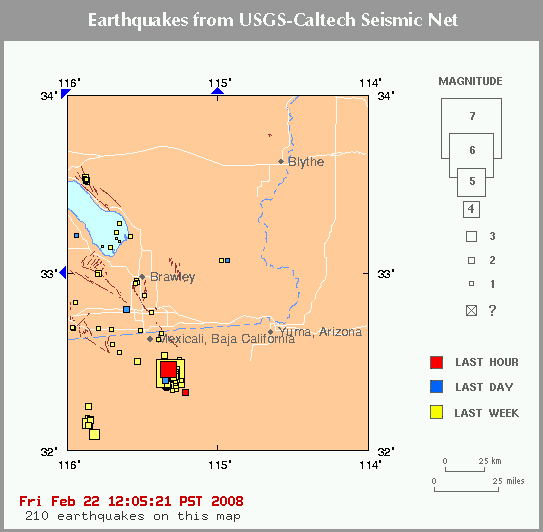
Earthquake swarm
Encyclopedia

Earthquake
An earthquake is the result of a sudden release of energy in the Earth's crust that creates seismic waves. The seismicity, seismism or seismic activity of an area refers to the frequency, type and size of earthquakes experienced over a period of time...
s striking in a relatively short period of time. The length of time used to define the swarm itself varies, but the United States Geological Survey
United States Geological Survey
The United States Geological Survey is a scientific agency of the United States government. The scientists of the USGS study the landscape of the United States, its natural resources, and the natural hazards that threaten it. The organization has four major science disciplines, concerning biology,...
points out that an event may be on the order of days, weeks, or months. They are differentiated from earthquakes succeeded by a series of aftershock
Aftershock
An aftershock is a smaller earthquake that occurs after a previous large earthquake, in the same area of the main shock. If an aftershock is larger than the main shock, the aftershock is redesignated as the main shock and the original main shock is redesignated as a foreshock...
s by the observation that no single earthquake in the sequence is obviously the main shock. Earthquake swarms are one of the events typically preceding eruptions of volcanoes
Volcano
2. Bedrock3. Conduit 4. Base5. Sill6. Dike7. Layers of ash emitted by the volcano8. Flank| 9. Layers of lava emitted by the volcano10. Throat11. Parasitic cone12. Lava flow13. Vent14. Crater15...
.
One example was the so-called "Mogul earthquake sequence" that began in February 2008 near Reno, Nevada
Reno, Nevada
Reno is the county seat of Washoe County, Nevada, United States. The city has a population of about 220,500 and is the most populous Nevada city outside of the Las Vegas metropolitan area...
and continued for several months, ending in November 2008. Between February and April the swarm produced more than 1,000 quakes of small magnitude, although the largest measured 4.7. Another example was that affecting the island of El Hierro
El Hierro
El Hierro, nicknamed Isla del Meridiano , is the smallest and farthest south and west of the Canary Islands , in the Atlantic Ocean off the coast of Africa, with a population of 10,162 .- Name :The name El Hierro, although phonetically identical to the Spanish word for 'iron', is generally thought...
. From July 2011 until October 2011, hundreds of small earthquakes were measured. The accumulated energy released by the swarm increased dramatically on 28 September. The swarm was due to the movement of magma
Magma
Magma is a mixture of molten rock, volatiles and solids that is found beneath the surface of the Earth, and is expected to exist on other terrestrial planets. Besides molten rock, magma may also contain suspended crystals and dissolved gas and sometimes also gas bubbles. Magma often collects in...
beneath the island, and on 9 October indications of a submarine volcanic eruption were detected.
See also
- Blanco Fracture ZoneBlanco Fracture ZoneThe Blanco Fracture Zone or Blanco Fault Zone is a transform fault zone running northeast off the coast of Oregon in the Pacific Northwest of the United States which runs between the Gorda Ridge to the south and the Juan de Fuca Ridge to the north...
- Earthquake stormEarthquake stormAn earthquake storm is a recently proposed theory about earthquakes, where one triggers a series of other large earthquakes—along the same plate boundary—as the stress transfers along the fault system. This is similar to the idea of aftershocks, with the exception that they take place...
- Gutenberg–Richter law
- Remotely triggered earthquakesRemotely triggered earthquakesRemotely triggered earthquakes have also been characterized as "the very long reach of very large earthquakes." Fundamentally, it is postulated that large earthquakes can have an influence outside of the immediate aftershock zone, and actually activate other earthquakes at considerable distance...
- SeismologySeismologySeismology is the scientific study of earthquakes and the propagation of elastic waves through the Earth or through other planet-like bodies. The field also includes studies of earthquake effects, such as tsunamis as well as diverse seismic sources such as volcanic, tectonic, oceanic,...

